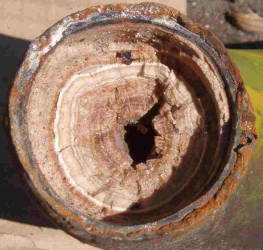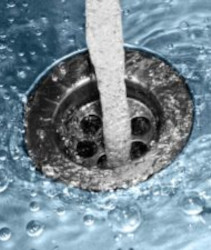There are a number of reasons for insufficient or low water pressure in a house. If the water supply form outside arrives with only 40 psi water pressure, the water pressure inhouse can of course not be higher. To increase this low water pressure you might need to install a pump. If a valve is stuck or not fully open, it can be responsible for low water flow and water pressure. If a pump that is no longer working properly, a corroded valve or constrictions in the water pipe can be other causes.

Particularly susceptible to low water pressure are pipes or sections of pipes, with low flow because of only little use or not at all for a while. Such as guest rooms or former children’s rooms in single-family homes. Or vacation homes that are only used seasonally. The water pipe is therefore not flushed frequently enough. As a result, corrosion is more likely to occur and substances from the water are deposited in the pipe. This accelerates the clogging of a water pipe or a water heater.
Water pressure too low? – Safe and gentle remedy without plumbing
The first thing to do is to check the water pressure at the water supply line at entrance into the house. That is, how many psi of water pressure the supplier delivers. In the basement there is usually a water meter, a shut-off valve and pressure-reducing valve with a gauge. There you can see how much psi water pressure is present. The pressure from the public network is usually higher than needed in the house. So the pressure is reduced to around 30 psi. This is sufficient for a normal one-family house. If the pressure from the supplier is not sufficient, a pump must be used to help and increase the pressure accordingly.
If there is a filter behind the pressure regulator, a higher pressure is needed, because up to 10 psi can be lost through the filter. The filter should be flushed or replaced regularly. A clogged filter can be the reason for too low water pressure at the tap.
The Merus ring is able to eliminate, what causes low water pressure. The buildup of limescale or corrosion are reliably detached and flushed out together with the water. Once the deposits have been removed after some time, the pressure and flow rate increase significantly again.
In smaller units, one Merus ring on the main water line in the basement is sufficient. It causes solids to dissolve much better in the water. Due to this higher solubility, the existing solid deposits are again dissolved in the water and gradually flushed out through the taps.
In medium sized units, up to about 10 apartments we recommend installing a second Merus ring to the hot water circulation return.
In large properties or complex water systems, Merus rings are also used. In such properties, several Merus rings are usually installed at different locations, to meet the demand of the building.
How to increase my water pressure – what can i do?

Turn at the faucet hot and cold water on full briefly, to flush both lines. In this way, the dissolved lime and rust will be flushed out as well. Remove the aerator from the faucet to accelerate the water flow.
In the first time, iron pipes may also come brown water. This is a sure sign that your pipes are clearing. This brown discoloration should stop after some time and the water should flow clear. If things go normally, the pressure will slowly rise again. How long it actually takes for the pipes to clear completely is hard to judge. It also depends on the lines themselves and the regularity of flushing.
A good way to check the success is to measure the volume. Or if you are set up also the pressure difference. You fill a vessel with water and stop the time needed. It’s best to do this before or right after the Merus installation. And repeat weekly thereafter. If the line is cleaned and thus free again, the vessel will be full faster.
It also sometimes happens that larger particles come loose. You can check this. Remove the aerator on the faucet and remove the loosened particles. We install Merus Rings at the beginning of the water pipe system to remove the existing deposits. In bigger and longer pipe systems, it might be required to install more then one Merus Ring, to ensure the same good effect into the last corner of the system.
The Merus technology ensures that no new deposits will form and on top removes the already existing incrustation. Thus the pipe diameter increases to its original diameter and the water pressure can go back to normal. Thus solved old deposits will be flushed out of the pipe, or settle in the cooling tower sump.
Nevertheless it can take some time until the pipes are fully clean again. What grew in years won’t be gone in seconds. You can monitor the improvement by checking the volume of water coming out of the pipe, you check the pressure drop, etc.
